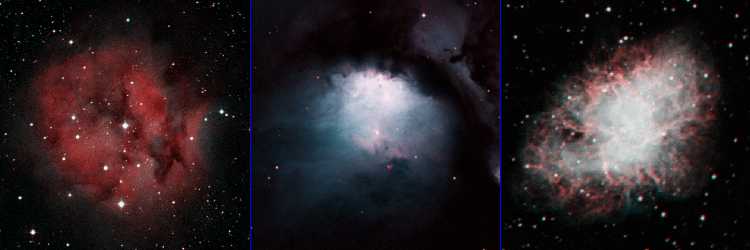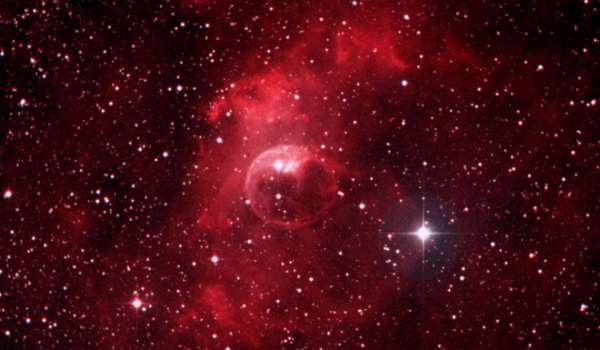
Las nebulosas brillantes son usualmente concentraciones de gas y polvo en donde las estrellas se forman. Hay tres tipos basicos :

Mas abajo una lista de nebulosas brillantes :
1 2 3 4 5 6 7 8 9 10 11
Numero Nombre Coordenadas Coordenadas Tipo de Tamaño Distancia Tamaño Const
NGC Comun Ecuatoriales Galacticas Nebulosa (arcmins) (al) (al)
RA (2000) Dec l° b°
7822 00 03,6 +68 37 118,6 +6,2 E 65'x20' 2800±400 50 Cep
281 00 52,8 +56 36 123,1 -6,3 E 30'x25' 8000±2000 70 Cas
IC59,IC63 Nebulosa Gamma Cas 00 56,7 +61 04 123,6 -1,8 RE 40'x10' 600±100 7 Cas
602 01 29,6 -73 33 299,2 -43,3 E 2'x1' 210000±10000 120 Hyi
IC1795,IC1805 Nebulosa Corazon 02 33,4 +61 26 134,8 +0,9 E 100'x80' 6000±500 170 Cas
IC1848 Nebulosa Alma 02 51,3 +60 25 137,2 +0,9 E 105'x60' 6500±500 200 Cas
1333 03 29,3 +31 25 158,3 -20,4 R 9'x7' 1100±? 3 Per
1432,1435 Nebulosa de Pleyades 03 47,0 +24 67 165,9 -22,8 R 180'x180' 400±25 20 Tau
1499 Nebulosa California 04 00,7 +36 37 160,1 -12,3 E 150'x40' 1500±500 70 Per
1491 04 02,9 +51 17 150,6 -1,0 E 3'x3' 10000±2000 9 Per
1554-55 Nebulosa Hind (T Tau) 04 21,8 +19 32 176,2 -20,9 R 1'x1' 500±200 0,2 Tau
1579 04 30,7 +35 15 165,5 -8,9 R 8'x12' 2600±? 9 Per
1624 04 40,0 +50 27 155,3 +2,5 E 3'x3' 20000±5000 17 Per
IC2118 Cabeza de Bruja 05 06,9 -07 13 207,3 -26,5 R 180'x60' 1000±500 50 Eri
IC405 05 16,2 +34 16 172,1 -2,3 RE 30'x20' 1700±500 15 Aur
IC410 05 22,2 +33 23 173,6 -1,8 E 20'x20' 11000±2000 60 Aur
1931 05 31,4 +34 14 173,9 +0,3 RE 8'x8' 5900±1000 14 Aur
1952 Nebulosa Cangrejo (M1) 05 34,5 +22 01 184,6 -5,8 S 6'x4' 7000±2000 12 Tau
-- Lambda Orionis (S264) 05 35,2 +09 56 195,0 -12,0 E 60'x60' 1400±300 25 Ori
1973,1975,1977 05 35,4 -04 50 208,5 -19,1 RE 40'x25' 1300±200 16 Ori
1976,1982 Nebulosa Orion (M42,M43)05 35,4 -05 27 209,1 -19,4 E 60'x60' 1300±200 25 Ori
1999 05 36,3 -06 43 210,4 -19,7 R 2'x2' 1300±300 1 Ori
2070 Nebulosa Tarantula 05 38,7 -69 06 279,5 -31,7 E 40'x25' 170000±10000 2000 Dor
IC434 Cabeza de Caballo 05 41,0 -02 24 206,9 -16,7 E 60'x10' 1300±300 25 Ori
2023-24 Nebulosa Llamarada 05 42,0 -01 50 206,5 -16,3 RE 30'x30' 1300±300 12 Ori
2068,2071 (M78) 05 46,7 +00 03 205,4 -14,3 R 30'x20' 1300±300 12 Ori
-- Lazo De Barnard (S276) 05 55,0 -01 30 207,8 -13,2 E 840'x60' 1300±300 350 Ori
2149 06 03,5 -09 44 216,3 -15,0 E 3'x2' ? - Mon
2174 06 09,8 +20 19 190,2 +0,4 E 40'x30' 6000±1000 70 Ori
IC443 06 17,0 +22 29 189,1 +2,9 S 50'x40' 5000±1000 70 Gem
2237-38-39,2246 Nebulosa Roseta 06 32,3 +05 03 206,3 -1,9 E 80'x60' 4700±1000 110 Mon
2261 Nebulosa Hubble (R Mon) 06 39,2 +08 44 203,8 +1,3 RE 2'x2' 3000±1500 2 Mon
2264 Nebulosa Cono (S Mon) 06 40,9 +09 54 202,9 +2,2 E 25'x15' 2200±500 16 Mon
2327,IC2177 Nebulosa Gaviota 07 04,0 -11 18 224,4 -2,4 E 150'x50' 3800±500 170 CMa
2359 Casco de Thor 07 17,6 -13 12 227,6 -0,3 E 10'x5' 20000±8000 60 CMa
2467 07 52,5 -26 24 243,2 +0,4 E 8'x7' 15000±3000 35 Pup
2736 Nebulosa Gum (parte de) 09 00,4 -45 54 266,9 +0,2 S 10'x20' 1500±500 9 Vel
3199 10 17,1 -57 55 283,6 -1,0 E 22'x20' 15000±3000 90 Car
3372 Nebulosa Eta Carinae 10 43,8 -59 52 287,5 -0,9 E 85'x80' 9000±1000 220 Car
3576,3581-82 11 12,1 -61 18 291,3 -0,7 E 30'x20' 6000±2000 50 Car
3603 11 15,1 -61 16 291,6 -0,5 E 20'x20' 20000±5000 120 Car
5367,IC4347 13 57,7 -39 59 316,5 +21,1 E 2'x1' 2100±500 1 Cen
IC4604 16 25,6 -23 26 353,7 +17,7 RE 60'x25' 600±200 10 Oph
6188 16 41,4 -48 05 337,2 -1,1 E 20'x12' 4400±1000 25 Ara
6334 Nebulosa Pata del Gato 17 20,3 -36 04 351,1 +0,6 E 40'x30' 5500±1000 60 Sco
6357 17 24,4 -34 09 353,2 +1,0 E 90'x60' 3300±800 90 Sco
6514 Nebulosa Trifid (M20) 18 02,6 -23 02 7,0 -0,3 RE 29'x27' 4000±1500 35 Sag
6523 Nebulosa Laguna (M8) 18 03,8 -24 23 6,0 -1,2 E 80'x40' 4500±1000 100 Sag
6611,IC4703 Nebulosa Aguila (M16) 18 18,8 -13 47 17,0 +0,8 E 35'x30' 5700±1000 60 Ser
6618 Nebulosa Omega (M17) 18 20,8 -16 11 15,1 -0,8 E 40'x30' 4500±1000 50 Sag
IC1287 18 31,3 -10 50 21,0 -0,5 R 5'x4' 1000? 2 Scu
6726-27,6729 Nebulosa R CrA 19 01,5 -36 54 0,0 -17,8 RE 10'x10' 420±50 1 CrA
6820 19 42,5 +23 05 59,1 -0,1 E 20'x20' 6500±1000 40 Vul
6888 Nebulosa Creciente 20 12,0 +38 21 75,5 +2,4 E 20'x10' 4000±1000 25 Cyg
IC1318 Nebulosa Gamma Cyg 20 22,2 +40 15 78,1 +1,9 E 50'x50' 4000±1000 60 Cyg
6960 Nebulosa Velo (Weste) 20 45,6 +30 42 73,3 -7,6 S 70'x6' 2000±700 40 Cyg
IC5067-68,IC5070 Nebulosa Pelicano 20 50,8 +44 21 84,6 +0,1 E 80'x70' 1900±500 40 Cyg
6992,6995 Nebulosa Velo (Este) 20 56,4 +31 43 75,6 -8,8 S 80'x8' 2000±700 50 Cyg
7000 Nebulosa Norte America 20 58,8 +44 20 85,5 -1,0 E 120'x100' 1900±500 70 Cep
7023 Nebulosa Lirio 21 01,8 +68 12 104,1 +14,2 R 18'x18' 1500±500 8 Cep
IC1396 21 39,0 +57 29 99,3 +3,7 E 170'x140' 2700±400 130 Cep
IC5146 Nebulosa Capullo 21 53,5 +47 16 94,4 -5,5 RE 10'x10' 3200±500 9 Cyg
-- Nebulosa Cueva (S155) 22 56,8 +62 37 110,2 +2,6 E 50'x30' 2400±500 35 Cep
7538 23 13,2 +61 29 111,5 +0,8 E 10'x7' 9000±3000 25 Cep
7635 Nebulosa Burbuja 23 20,7 +61 12 112,2 +0,2 E 15'x8' 12000±3000 50 Cas
Columna 1: Numero del catalogo NGC (o IC) de la nebulosa.
Columna 2: Nombre comun de la nebulosa.
Columna 3: Ascension derecha en horas y minutos del año 2000.
Columna 4: Declinacion en grados y minutos del año 2000.
Columna 5: Longitud Galactica de la nebulosa.
Columna 6: Latitud Galactica de la nebulosa.
Columna 7: Tipo de nebulosa, Emision (E), Refleccion (R) o Remanente de Supernova (S).
Columna 8: Tamaño angular de la nebulosa en minutos de arco.
Columna 9: Distancia en años luz de la nebulosa con su correspondiente error.
Columna 10: Diametro de la nebulosa en años luz calculado usando la distancia y el tamaño angular.
Columna 11: Constelacion en donde se encuentra la mayoria de la nebulosa.
Referencias:
Clark R, (1990), Visual Astronomy of the Deep Sky. Cambridge University Press.
Blitz L, Fich M., Stark A., (1982), Catalog of CO Radial Velocities
toward Galactic H II Regions. Astrophys J Supp, 49, 183.
Caswell J, Haynes R, (1987), Southern HII Regions: an extensive study of radio
recombination line emission. Astron. Astrophys. 171, 261.
Cruz-Gonzalez C, Recillas-Cruz E, Costero R, Peimbert M, Torres-Peimbert S, (1974),
Catalogue of Galactic O Stars. Rev. Mex. Astron. Astrof. 1, 211.
Codella C, Felli M, Natale V, Palagi F, Palla F, (1994), The occurrence of H2O masers
in HII regions. Astron. Astrophys. 291, 261.
Guarinos J, (1992), Interstellar matter in the Galactic Disk, Catalogue of Extinctions
and Distances Derived from UBV data.
